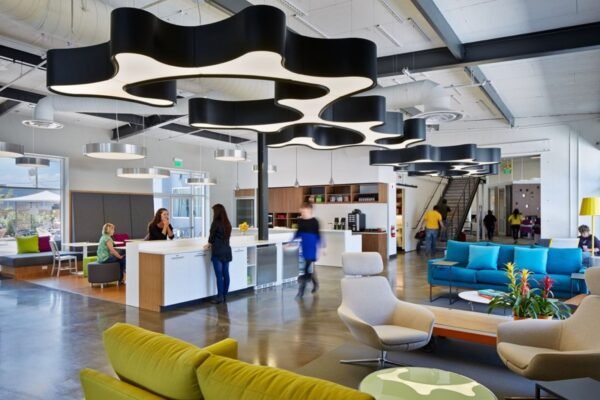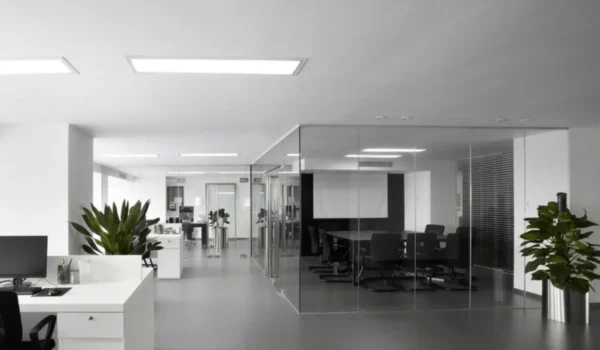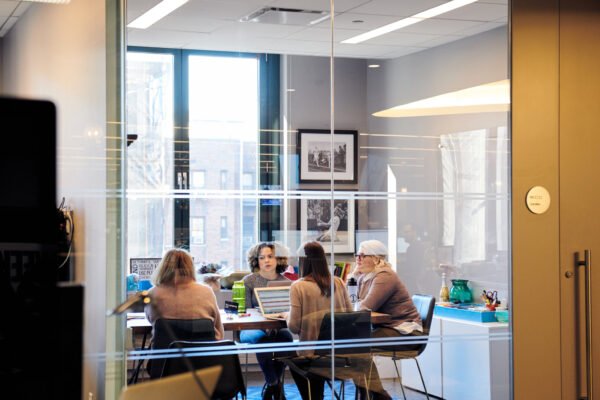
The journey away from cubicles to the expanses of open-plan offices promised a new frontier for collaboration and creativity. Yet, amidst this transition, a critical question arose: Does an open workspace genuinely enhance productivity and foster innovation?
It’s crucial to dig beneath the surface, recognising that the impact of office design extends far beyond its initial aesthetic appeal. It touches the very heart of employee satisfaction and efficiency.
Recent findings by the American Society of Interior Designers offer a quantifiable glimpse into this dynamic, revealing that workers who are pleased with their office environment report a staggering 31% increase in productivity. This statistic is not just a number; it’s a testament to the profound effect our surroundings have on our work life.
As we venture through various office layouts and their correlations with employee output, we begin to unravel a complex tapestry of design principles, worker needs, and the evolving ethos of work culture. This exploration is not merely about critiquing the past; it’s about paving the way for innovative solutions that harmonise individual well-being with collective efficiency.

The Shift in Office Design Philosophy
The landscape of office design has undergone a significant metamorphosis over the decades, driven by a deeper understanding of employee needs and the evolving nature of work itself. Gone are the days when rows of cubicles and a rigid corporate environment defined the workspace. In recent years, a seismic shift towards designs that emphasise employee well-being and flexibility has taken centre stage. Sheena Doherty, a senior consultant at St James’s Place partner practice Sovereign Wealth, encapsulates this movement succinctly: “Competitive employers are embracing employee wellbeing as an investment in their teams and a reflection of their values.”
This statement is more than an observation; it’s a reflection of a broader cultural change towards valuing the health and happiness of employees as a cornerstone of productivity and success.
As offices transition from mere places of work to environments that support and enhance the human experience, the philosophy guiding their design has pivoted towards creating spaces that are not only functional but also nurturing. This evolution acknowledges that employee productivity is inextricably linked to their physical and psychological comfort. It’s a recognition that the aesthetics of an office, its layout, and the opportunities it presents for privacy, collaboration, and relaxation are not just additional benefits but essential components of an effective workspace. In this new era, office design has become a tangible expression of a company’s ethos and a critical tool in attracting and retaining talent.
Statistical Insights: Office Layouts and Employee Productivity

The narrative that open-plan offices enhance collaboration and drive innovation has been dominant for years. However, empirical evidence suggests a more nuanced reality. A pivotal study by Harvard Business School reveals a counterintuitive outcome of the open-office model: a 70% decrease in face-to-face interactions accompanied by a 50% surge in electronic communication. This statistic challenges the foundational premise of open-plan layouts, suggesting that such environments might actually hinder the very collaboration they seek to foster.
Further compounding the case for reevaluated office designs, the Green Building Council report highlights the tangible impact of environmental factors on productivity. According to the report, optimal air quality and ventilation can boost productivity by as much as 11%, while poor conditions could detract 10% from overall performance. Temperature extremes, whether too hot or too cold, also have a discernible effect, potentially reducing productivity by 4-6%. These statistics offer a compelling argument for office designs that prioritise environmental comfort and adaptability. They underscore the importance of creating spaces that respond to the physiological and psychological needs of employees, thereby setting the stage for enhanced productivity and well-being.
Office Pods: An Office Benefit
In the quest for balancing the need for collaboration with the equally important need for privacy, one innovative solution has emerged as a frontrunner: office pods. Furnify, among others, has recognised this gap in the modern workspace. Furnify offers a variety of office pod solutions, including office pods, meeting pods, and work pods. These self-contained units provide a sanctuary for focus and confidentiality, addressing the pressing demand for personal space in the increasingly open and collaborative office landscapes.
Office pods stand out not only for their functionality but also for their flexibility. They can be installed in existing office spaces without the need for extensive renovations, making them a practical solution for companies looking to adapt to the evolving needs of their workforce. The introduction of office pods into the workplace is more than a nod to the importance of privacy; it’s a commitment to creating a diversified work environment that caters to the myriad ways in which people work best. By offering a retreat from the buzz of the open office, pods allow employees to control their interaction levels, engage in deep work without interruptions, and ultimately, enhance their productivity and well-being. As businesses continue to navigate the complexities of the modern workplace, the integration of office pods represents a significant step towards a more adaptive and human-centric office design.
The Role of Privacy in Enhancing Efficiency
The open-plan office, with its promise of increased collaboration and transparency, has often overlooked one crucial aspect of work life: the need for privacy. The discourse around workplace efficiency frequently neglects the silent but potent role that a sense of personal space plays in employee productivity. Writers Dawn Robertson and Kimberley Tochel from People Management highlight a significant facet of this oversight, stating, “Employees who feel their privacy rights have been violated, or that their employer has acted in a manner that has undermined the employment relationship, may raise court or tribunal proceedings against them. A clear and well-communicated policy around the nature and extent of any monitoring is essential to minimise the risk.”
This quote brings to light the broader implications of privacy in the workplace, not just in the physical sense but also in terms of data and personal information.
Privacy concerns in an open office go beyond legal ramifications; they touch the core of employee satisfaction and efficiency. A staggering 37% of people working in open-plan offices believe that the design of their workspace decreases their productivity. This statistic isn’t merely a number—it’s a reflection of the growing discontent among workers who find themselves constantly in the view and earshot of their colleagues. The lack of private spaces can lead to increased stress levels, decreased concentration, and a notable decline in job satisfaction. As the conversation around office design continues to evolve, it becomes clear that incorporating elements of privacy is not a luxury but a necessity for fostering an environment where employees can thrive.
Conclusion: Redefining Workspace Efficiency
The journey through the evolving landscape of office design highlights a pivotal shift in understanding workplace efficiency. From the monolithic rows of cubicles to the vast, open-plan expanses, and now, towards more nuanced, hybrid environments that incorporate privacy pods and focus areas, the trajectory of office design mirrors a deeper comprehension of what truly drives productivity and employee satisfaction. The statistics and insights drawn from various studies underscore a fundamental truth: efficiency is not merely about physical space but about creating environments that respond to the diverse needs of the workforce.
The revelation that a significant proportion of workers are more productive in environments they find aesthetically pleasing or that offer them a degree of privacy and control over their workspace challenges the generic approach that has dominated for so long. Instead, it calls for a more adaptable, thoughtful approach to office design, one that values the individual without sacrificing the collective. The introduction of office pods by companies like Furnify is a testament to the industry’s responsiveness to these evolving needs, offering a solution that marries privacy with openness, solitude with collaboration.
As we look towards the future of work, it’s clear that the physical office will continue to play a crucial role in shaping corporate culture, employee engagement, and overall productivity. The challenge for designers, managers, and business leaders is to continue seeking out and implementing design solutions that are as dynamic and multifaceted as the workforce they aim to support. By leveraging the insights gained from statistical analyses and embracing innovative solutions like office pods, businesses can create workspaces that are not only more efficient but also more humane.
In this ongoing narrative of office design, the ultimate goal remains constant: to foster environments where creativity flourishes, productivity is enhanced, and employees feel genuinely supported. The future of work is not about eschewing the past but about building upon it, integrating the best of what we’ve learned to create spaces that are inclusive, adaptable, and, above all, effective. As we move beyond the open plan, it’s clear that the statistics behind office design are more than just numbers—they’re a roadmap to a more engaged, satisfied, and productive workforce.
